Rise & Shine - August 25
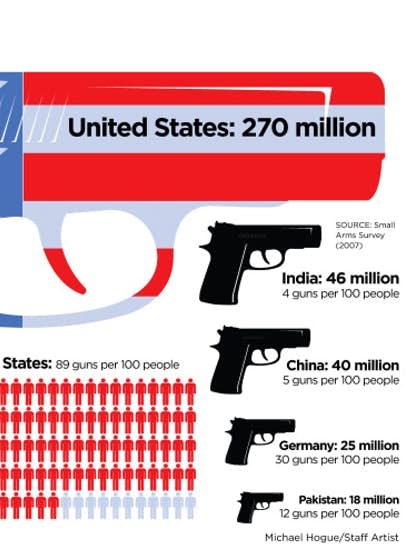
How Should America Approach Our Gun Violence Problem?
Rise & Shine, August 25th
The Rise and Shine discussion group meets Sunday mornings at 9:00 am in the Parlor. Adults from the 8:00 & 10:00 services gather for discussions that are relevant to their lives through the lens of a current topic and scriptural references. This week's discussion outline can be read or downloaded below.
Click Here to download this week's discussion outline
Questions:
- What surprises you most about the various data and graphs given below?
- Other than the number of guns available, what else might contribute to America’s high gun death rate relative to other countries?
- How are your views on gun legislation related to your faith convictions?
- Which, if any, of the suggestions below intrigue you most? Which are you most skeptical of?
In the News
How to Reduce Shootings
The first step is to understand the scale of the challenge America faces: The U.S. has more than 300 million guns – roughly one for every citizen – and stands out as well for its gun death rates. At the other extreme, Japan has less than one gun per 100 people, and typically fewer than 10 gun deaths a year in the entire country.
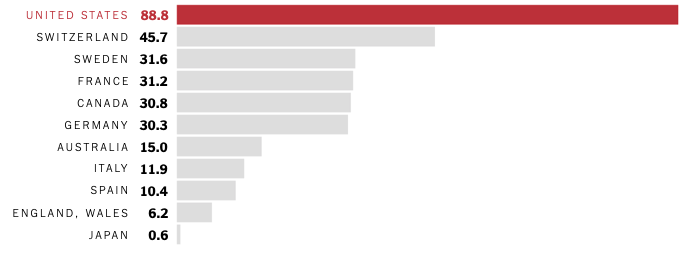
Gun Murders per 1000 people
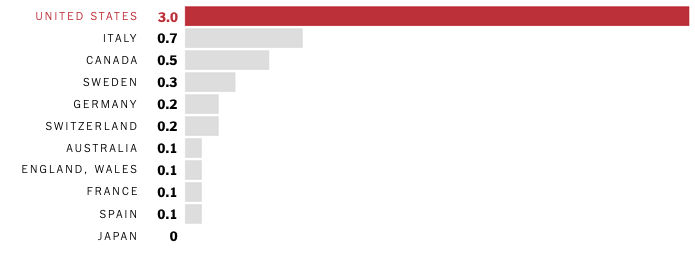
Automobiles can be a model for the public health approach this author suggests to put a dent in gun violence. Cars kill about as many people as guns, yet we don’t ban them. However, we do work hard to regulate them – and limit access to them – so as to reduce the death toll they cause. This has been spectacularly successful, reducing the death rate per 100 million miles driven by 95 percent since 1921. This can be seen in the graph below depicting the history of motor vehicle safety since World War II:
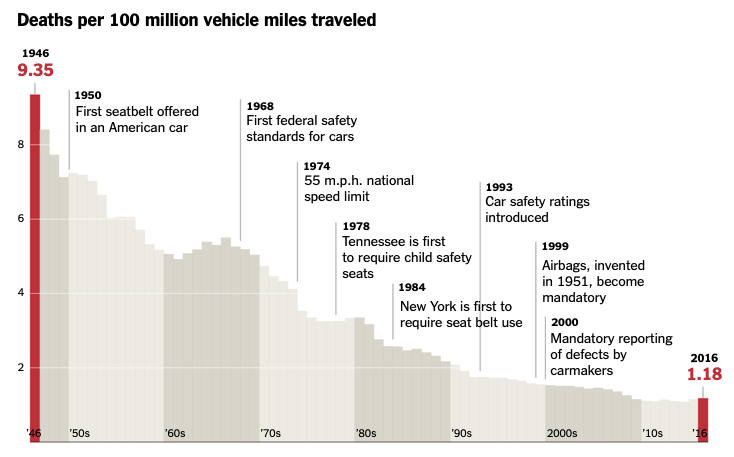
Liberal opposition to guns has often been ineffective, and sometimes counterproductive. The 10-year ban on assault weapons accomplished little, partly because definitions were about cosmetic features like bayonet mounts (and partly because even before the ban, such guns were used in only 2 percent of crimes).
Focusing on “gun control” scares off gun owners and leads to more gun sales. A better framing is “gun safety” or “reducing gun violence,” and using auto safety as a model—constant efforts to make the products safer and to limit access by people who are most likely to misuse them.
What would a public health approach look like for guns if it were modeled after cars? It would include:
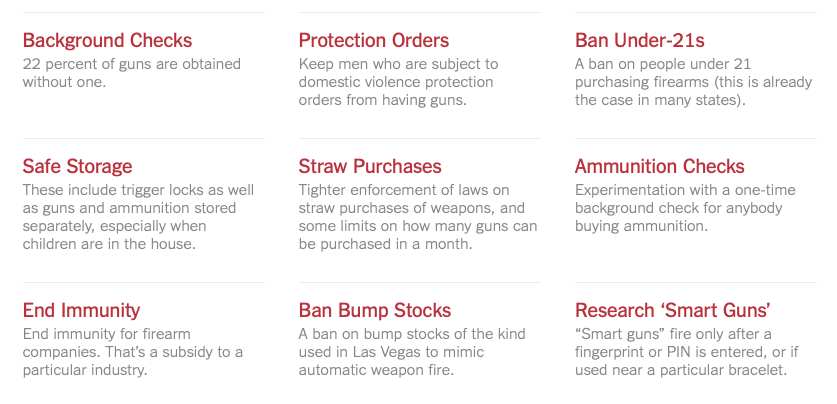
The most out of the box solution above may be Smart Guns. If someone steals an iPhone, it’s useless, and the same could be true of guns. Gun manufacturers made child-proof guns back in the 19th century (before dropping them), and that technology today could be advanced today. Some combination of smart guns and safe storage would also reduce the number of firearms stolen in the U.S. each year, now about 200,000, and available to criminals.
There isn’t much research as to whether gun buyback programs are successful in decreasing gun violence. Of the 50 US states, only Delaware has a gun death rate above the national average while having a guns per capita rate above the national average. Of the 41 states where more than 32% of households own guns, 12 have gun death rates below the national average.
There is also evidence to suggest that states with stricter gun laws have lower gun death rates. The Law Center to Prevent Gun Violence finds that states where guns are more regulated tend to have lower gun death rates. In its grading system, the strongest gun regulations get an “A;” the weakest, an “F.”
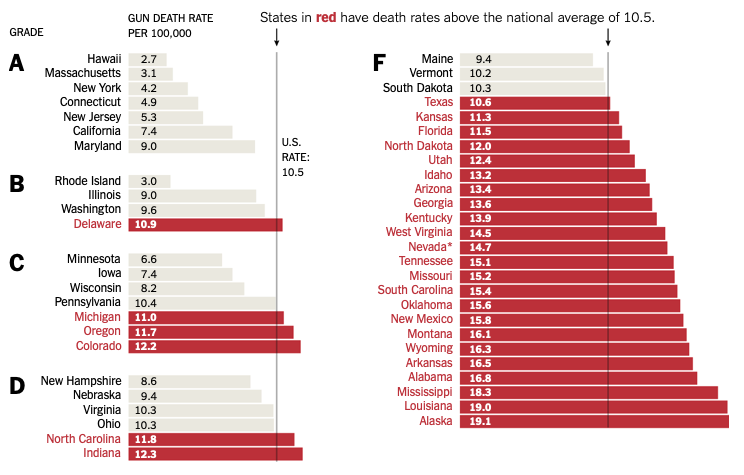
One major problem is that lax laws too often make it easy not only for good guys to get guns, but also for bad guys to get guns. The evidence is overwhelming that overall more guns and more relaxed gun laws lead to more violent deaths and injuries.
Critics will say that the kind of measures I cite wouldn’t prevent many mass shootings. The Las Vegas carnage, for example, might not have been prevented by any of the suggestions above. Mass shootings may get our attention, but they are not the main cause of loss of life. Much more typical is a friend who shoots another, a husband who kills his wife – or, most common of all, a man who kills himself. Skeptics will say that if people want to kill themselves, there’s nothing we can do. In fact, it turns out that if you make suicide a bit more difficult, suicide rates drop.
In 2016 there were an estimated 22,000 gun deaths by suicide and 11,760 by homicide, while only 589 deaths were attributed to self-defense and 456 to mass shootings.
Comparing states that either increase or decrease gun safety laws can also lead to some revelation about the difference gun laws can make. In 1995, Connecticut tightened licensing laws and experience a 40% drop in firearm homicide rates. In comparison, in 2007 Missouri eased gun laws and saw their gun homicide rates increase by 25% after. Similarly, suicide by gun rates dropped by 15% in Connecticut and rose by 16% in Missouri. Correlation doesn’t prove causation, and many factors can increase or decrease death rates, however, the information above does provide one data point.
Polls show that most Americans agree on some kinds of curbs on guns. Just like nobody believes that people should be able to drive a tank down Main Street, or have an anti-aircraft gun in the backyard, the question isn’t whether we will restrict firearms, but where to draw the line and precisely which ones to restrict. Here are some poll numbers on gun issues:
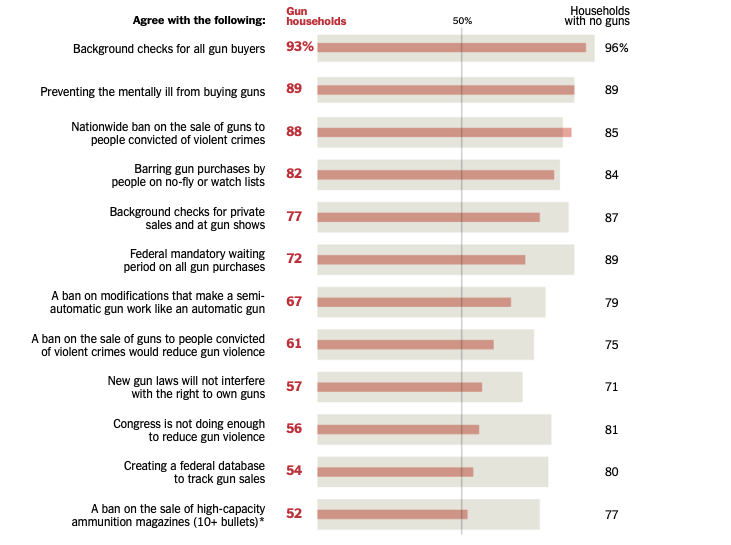
The fact is that more Americans have died from gun violence, including suicides, since 1970 (about 1.4 million) than in all the wars in American history going back to the Revolutionary War (about 1.3 million). And this isn’t just about typical criminal behavior. Most years, more preschoolers are shot dead in America (about 75) than police officers are.
There are no perfect solutions to gun violence. The Second Amendment, our polarized political system, and the power of the gun lobby make passing any laws difficult. However, automobiles are a reminder that we can chip away at a large problem through a public health approach: Just as auto safety improvements have left us far better off, it seems plausible to some gun policy experts that a sensible, politically feasible set of public health steps could over time reduce firearm deaths in America by one-third – or more than 10,000 lives saved each year.
Regardless of your political leanings, you probably believe that something should be done about the number of gun deaths in America each year. Conservatives and Liberals alike can use the suggestions above to band together and start this “something.”
More on this story can be found at these links:
How to Reduce Shootings.The New York Times
There are now more guns than people in the United States.The Washington Post
The Violence Project
Prayer in Response to Gun Violence (The Rev. Dr. Ellen Clark-King, Executive Pastor and Canon for Social Justice – Grace Cathedral; San Francisco, CA)
Let us lament with all those who are touched by gun violence
Let us lament the shooter’s choice for violence
Let us lament laws that allow violent men easy access to guns
Let us lament our politicians’ unwillingness to work for change
Let us lament with the hearts broken by loss today
Let us lament all the lives cut short today
Let us lament, O God, and then let us rise from our knees to work for change
In the name of Christ, the prince of peace. Amen.